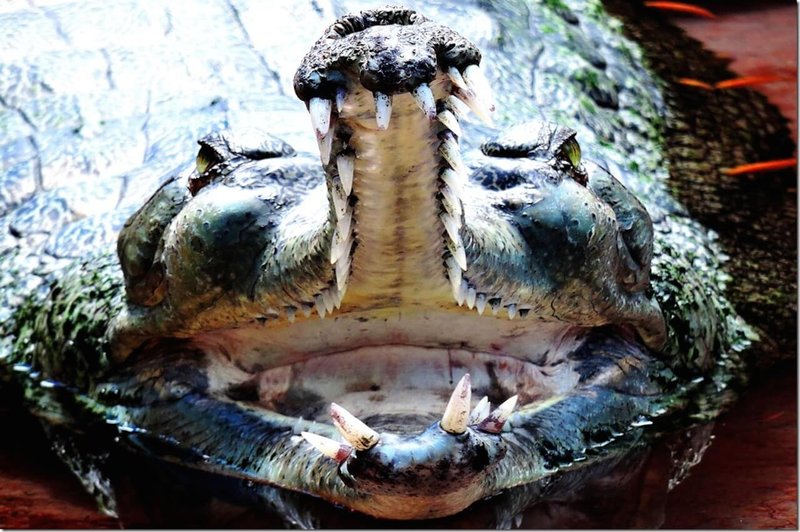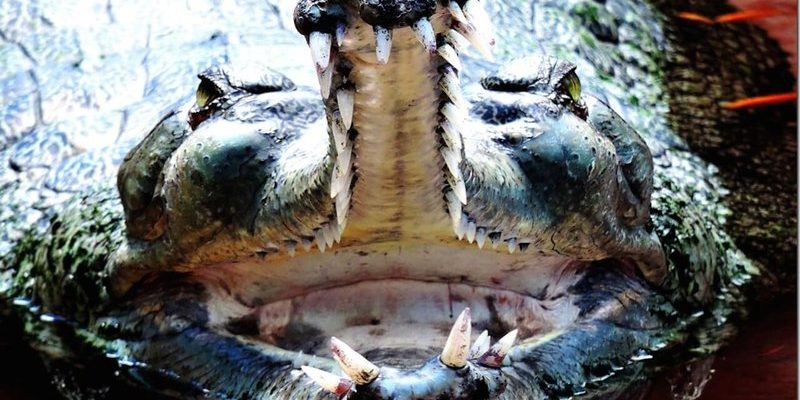
The Gavial, commonly known as the Gharial, is one of the most fascinating reptiles on the planet. Imagine a creature that looks like a cross between a crocodile and an eel, with a long, thin snout that seems designed specifically for catching fish. This unique appearance makes the Gharial unlike any other crocodilian species. They glide gracefully through water, using their streamlined bodies to hunt with precision. If you’ve ever been curious about this intriguing animal, you’re in the right place!
Gharials are primarily found in the river systems of the Indian subcontinent, particularly in India and Nepal. They prefer shallow waters where they can hunt for their main diet of fish. But these reptiles are more than just their looks; they also play a vital role in their ecosystem. By keeping fish populations in check, they help maintain a balanced aquatic environment. However, they are critically endangered due to habitat loss and pollution. Let’s dive deeper and explore what makes the Gavial so special.
Physical Characteristics
The physical traits of the Gavial are what set it apart from its crocodilian cousins. First off, the Gavial can grow quite large, reaching lengths of up to 20 feet! Their slender, elongated snouts are filled with sharp, pointed teeth specifically shaped for grasping fish. Unlike other crocodilians, they don’t have the broad, powerful jaws designed for cracking shells or tearing apart large prey. Instead, they are built for speed and agility, making them excellent swimmers.
Another striking feature of the Gavial is the bulbous growth at the end of the male’s snout, known as a “gharial,” which helps in attracting mates. This distinctive feature resembles a small, rounded egg and can be quite a sight! The coloration of the Gharial’s skin tends to be a dark olive green, helping them blend into their riverine habitats. This form of camouflage helps them hunt effectively, remaining hidden until the right moment to strike.
These reptiles also have long tails, which aid in their swimming abilities. With the ability to swiftly navigate through the water, they can outmaneuver their fishy prey. The Gharial’s four limbs are not used for walking on land, as they are more suited to help it steer and stabilize in the water. All of these features come together to create a creature that is perfectly adapted to its aquatic lifestyle.
Habitat and Distribution
The natural habitat of the Gavial consists mainly of rivers and riverside areas in the Indian subcontinent. They thrive in calm waters with sandy banks, where they can bask in the sun and rest. Primarily found in the Ganges River and its tributaries, Gharials are also spotted in rivers in Nepal, Pakistan, and parts of Bangladesh. The availability of fish is crucial for their survival, which is why they prefer these specific river systems.
Unfortunately, habitat destruction due to dam construction, irrigation projects, and pollution has greatly affected the Gharial’s population. Many rivers have seen drastic changes, making them unsuitable for these unique reptiles. Deforestation and human encroachment have also led to a reduction in their natural habitats. As a result, the Gavial is now classified as critically endangered by the IUCN.
Conservation efforts are underway to protect the remaining Gharial populations and restore their habitats. Organizations are working to clean up river systems and reduce human activity along the banks, crucial steps to ensuring that these magnificent creatures can continue to thrive in the wild. Keeping the ecosystems healthy is essential for the survival of the Gharial.
Diet and Feeding Habits
The Gavial has a diet that primarily consists of fish. Its long, narrow jaws are perfectly adapted for catching these slippery swimmers. Think of it like using chopsticks to pick up sushi—very specific and specialized! Gharials use their speed and stealth to approach schools of fish, snapping up their prey with incredible precision.
Interestingly, Gharials do not have the ability to eat larger prey like other crocodilians. You won’t find them munching on birds or mammals. This specialization in diet means that they play a vital role in controlling fish populations in their habitats. They’re often seen basking on the banks, waiting for the right moment to catch their next meal.
Feeding mainly occurs during the day, often in shallow waters where the fish congregate. In the evening, Gharials bask under the sun to warm up and save energy for the next day’s hunt. This combination of hunting and basking is crucial for their survival, allowing them to maintain their energy levels and stay agile. The balance of their diet and hunting habits is essential for the health of their aquatic environment.
Reproduction and Lifespan
When it comes to reproduction, Gharials have some particular habits that are quite interesting. Mating typically takes place in the rainy season, which coincides with the rising water levels of their river habitats. After mating, females will lay their eggs in nests dug into sandy banks. Each nest can contain around 30 to 50 eggs, which the female covers with sand for protection.
Once the eggs hatch, the tiny hatchlings are around 10 inches long. It’s fascinating how these little creatures already resemble their parents in their long, thin snouts! They stay close to their mothers for protection during their early days. Gharials reach sexual maturity around the age of 10 to 15 years, which is a considerable time for a reptile.
The lifespan of a Gavial in the wild can be up to 50 years, while those in captivity might live even longer. This long life expectancy is a testament to their adaptability and resilience, but it also means that conservation efforts need to be sustained over a long period to ensure their survival. Protecting their breeding grounds is essential to help the populations recover.
Conservation Status
As we’ve touched on earlier, the Gharial is critically endangered. The challenges they face are many, from habitat loss to pollution and illegal fishing. The degradation of their river habitat due to human activities has led to a dramatic decline in their numbers over the years. It’s estimated that there are only a few hundred breeding individuals left in the wild.
Conservation programs are critical to helping the Gavial population bounce back. One successful initiative has been the breeding and release programs that have taken place in recent years. These efforts aim to raise Gharial hatchlings in controlled environments and then release them back into their native habitats. This has shown promise, as more Gharials are reintroduced to the wild and begin to thrive.
In addition to breeding programs, there is also a growing awareness of the need for cleaner river environments. Efforts are underway to tackle pollution and overfishing, ensuring that Gharials have the best chance at survival. Community involvement is crucial here; locals are often the best stewards of their natural habitats, and by educating them, we can create a network of support for the Gharial and its environment.
Interactions with Humans
Gharials have had varied interactions with humans throughout history. In some cultures, they have been revered as sacred creatures, while in others, they have been viewed with fear. Historically, their habitat overlaps with human activities like fishing and farming, leading to conflicts over space and resources. Unfortunately, the decline in Gharial numbers has often gone unnoticed by the general public, which has hindered conservation efforts.
Today, ecotourism is becoming a way for communities near Gharial habitats to benefit from their presence. By promoting responsible tourism, locals can showcase these fascinating reptiles, helping to raise awareness about their plight. When people see Gharials up close, they often develop a connection that fosters a desire to protect them. Educational programs and guided tours can help people appreciate the ecological role that Gharials play.
However, it’s vital that any human interaction remains respectful. Overcrowding can disturb their natural behavior, and littering or pollution can endanger their habitats. By promoting a culture of conservation-minded individuals, we can create a future where both Gharials and humans coexist harmoniously.
Unique Facts about the Gavial (Gharial)
| Scientific Name: | Gavialis gangeticus |
| Size: | Up to 20 feet in length |
| Weight: | Up to 1,000 pounds |
| Diet: | Primarily fish |
| Lifespan: | Up to 50 years |
| Habitat: | River systems in the Indian subcontinent |
| Conservation Status: | Critically Endangered |
FAQ
What is the difference between a Gavial and a crocodile?
The main differences lie in their physical features and behavior. Gharials have long, thin snouts designed for catching fish, while crocodiles have broader snouts that allow them to hunt larger prey. Additionally, Gharials are predominantly aquatic and spend most of their time in water, whereas crocodiles can be seen on land as well as in water.
How can I help with Gharial conservation efforts?
You can contribute to Gharial conservation by supporting organizations that focus on wildlife protection, volunteering for local conservation projects, or even spreading awareness among your friends and family. Every small action counts, from reducing pollution in local waters to practicing responsible tourism.
Are Gharials dangerous to humans?
Generally, Gharials are not considered a threat to humans. Their diet consists mainly of fish, and they tend to avoid humans unless provoked. However, like all wild animals, it’s important to respect their space and avoid approaching them too closely.
What role do Gharials play in their ecosystem?
Gharials help maintain a healthy balance of fish populations in their habitats, ensuring that the aquatic ecosystem remains stable. By controlling fish numbers, they prevent overpopulation and depletion of resources, making them a crucial part of their aquatic environment.
Where can I see Gharials in the wild?
Gharials can be observed in several protected areas and national parks in India and Nepal, such as the Chandra Prabha Wildlife Sanctuary and the National Chambal Sanctuary. Visiting these locations can provide an opportunity to see these wonderful reptiles up close while supporting conservation efforts.
Why are Gharials endangered?
Gharials are endangered mainly due to habitat loss, pollution, and overfishing. The degradation of river habitats along with dams and other human activities has severely impacted their population numbers. Conservation efforts are ongoing to address these issues and protect the remaining Gharials.
How long do Gharials live in captivity?
In captivity, Gharials can live longer than in the wild, sometimes exceeding 50 years. This extended lifespan is often due to the absence of predators, a stable food supply, and regular veterinary care that helps sustain their health over time.
Can Gharials be kept as pets?
Keeping Gharials as pets is not advisable. They require specialized care, a large aquatic habitat, and a diet that is difficult to replicate in captivity. Moreover, owning a Gharial often requires special permits and can be illegal in many regions due to their endangered status.
What is the breeding process for Gharials?
The breeding process for Gharials typically occurs during the monsoon season. After a mating ritual, females lay eggs in nests constructed in sandy riverbanks. The mother protects the nests until they hatch, and the tiny hatchlings are guided to water for their first swim.
What steps are being taken to conserve Gharials?
Conservation efforts for Gharials include habitat restoration, breeding programs, and raising public awareness about their endangered status. Organizations are working to improve river ecosystems by reducing pollution and promoting protective legislation, all vital for ensuring a future for these unique reptiles.

